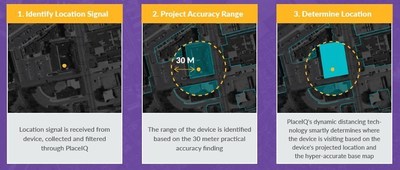TMCnet News
New Research Study Reveals the State of Location Data Accuracy, Finds Average Accuracy for Mobile Devices to be 30 Meters; PlaceIQ Introduces Dynamic Distancing Technology to Bring Unprecedented Accuracy to Brands and Media AgenciesNEW YORK, May 25, 2016 /PRNewswire/ -- PlaceIQ, the company building a new model of consumer behavior by connecting physical and digital activities across time, space and mobile devices today announced a new report entitled "Location Data Accuracy Revealed," which includes results from an industry-first research study on location data accuracy.  PlaceIQ commissioned independent research from Findyr, a global technology company that provides brands with custom data and analyses, to conduct the study. The new study consisted of an independent, third-party analysis of more than 150 physical locations across five U.S. cities and found that on average, location data obtained via mobile smartphones is accurate up to 30 meters. In addition, the average finding for location data accuracy varied in each of the five U.S. cities analyzed, which included Boston, MA (21 meters), New York City, NY (27 meters), Austin, TX (28 meters), Washington, D.C. (29 meters), and Chicago, IL (38 meters). These findings are demonstrative of the complex relationship between multiple factors that affect location data accuracy, such as signal source (GPS signals, Wi-Fi, cell tower triangulation), environment (area density, skyline view, indoor or outdoor location), and personal use (location data access enabled, type of mobile app used, operating system usage). "Location data can paint a vastly different picture depending on the situation," said Steve Milton, CTO at PlaceIQ. "Think of location as the sum of multiple parts and circumstances, each bringing different layers of clarity. The analysis in our report illustrates this. Building height, composition and density all contribute to the ability of mobile devices to emit an accurate signal to generate location. Cities like Chicago and New York are both very dense and offer opportunities for devices to connect to Wi-Fi signals, which aids in determining accuracy. What they also have however, are tall buildings that prevent quick connections to GPS signals, which traditionally provide the most accurate location data. A common example of these inconsistencies are ride hailing apps that determine location less effectively in different situations. A mixture of physical infrastructure and Wi-Fi density are the key for location accuracy, so it makes sense that Boston--a city with the best combination of building density for allowing for Wi-Fi access, without the abundance of skyscrapers that would inhibit GPS signal reception--would perform the best in this test." To gather the data, more than 150 participants visited verified points of interest in U.S. cities, such as retail locations, restaurants, sports arenas, universities, museums and noteworthy landmarks. Each participant recorded the exact latitude and longitude coordinates indicated by their mobile devices at these locations, which were then analyzed against the verified physical locations of each point of interest.  Other noteworthy findings from the report include:
In addition to the study, the PlaceIQ research report "Location Data Accuracy Revealed" offers marketers a way to understand how the interplay between signal source, mobile app usage, area density and mobile device operating system can influence the location data they implement. "Location data is a critical part of every successful marketer's arsenal," said Duncan McCall, CEO at PlaceIQ. "It continues to act as a versatile resource for both informing marketing decisions across verticals and as a horizontal enabler of broader business decisions at every level. This report's goal is to educate, cut through the marketing hype, and demystify the technology that brands are using to better understand, engage with, and drive sales. Only with a foundation grounded in truth and accurate data can the broader location industry thrive. The world's most innovative brands and media agencies continue to turn to PlaceIQ's innovations in location accuracy for this reason." PlaceIQ arms brands and their media agencies with privacy-conscious consumer insights by observing opted-in data from 100 million unique mobile users and more than 10 billion location-enabled data points every day. For more than 6 years, the company has pioneered the use of location technology for marketing and has developed advanced methodologies for ensuring data accuracy. PlaceIQ Innovations in Location Accuracy As part of today's news, PlaceIQ is announcing a new technology purpose-built to deliver an enhanced understanding of location accuracy, called Dynamic Distancing. This technology is exclusive to PlaceIQ and dynamically accounts for variability in location signals when determining visitation, to help marketers confidently understand user behavior. Dynamic Distancing transforms location intelligence and enables new marketing insights by coupling an understanding of mobile devices, both in movement and at rest, with the highest quality base map in the industry. This technology uses a three stage process to attribute a device's presence to a venue, both instantaneously for ad serving and retroactively for post campaign behavioral analysis and media measurement. When post-processing data for behavioral analysis or visitation measurement, Dynamic Distancing evaluates streams of movement information to identify when a visit begins to take place. As a device slows and its locations cluster, Dynamic Distancing determines the outer boundary of the visit based on the accuracy of the data coming in and the size of the cluster being formed by the device's movement. Then, Dynamic Distancing evaluates all mapping information contained within the computed boundary to determine the most likely venue being visited. "Greater accuracy can be obtained when evaluating many points of movement," continued McCall. "Specifically delivering ads to a device when it is in store sometimes requires determining visitation based off a single point. In these cases, PlaceIQ uses known adjustment factors for data source and device type to calibrate Dynamic Distancing in real time. Through these innovations, PlaceIQ continues to offer the most reliable and granular view of location available to marketers."  Dynamic Distancing is an exclusive offering by PlaceIQ, made possible by leveraging the company's legacy of unique technology advancements. These advancements include several industry-firsts:
To download a full copy of the report, please visit PlaceIQ's landing page. About PlaceIQ Logo - http://photos.prnewswire.com/prnh/20160112/321475LOGO Photo - http://photos.prnewswire.com/prnh/20160524/371752 Photo - http://photos.prnewswire.com/prnh/20160524/371751 To view the original version on PR Newswire, visit:http://www.prnewswire.com/news-releases/new-research-study-reveals-the-state-of-location-data-accuracy-finds-average-accuracy-for-mobile-devices-to-be-30-meters-placeiq-introduces-dynamic-distancing-technology-to-bring-unprecedented-accuracy-to-brands-and-media-agenci-300274737.html SOURCE PlaceIQ 
|
